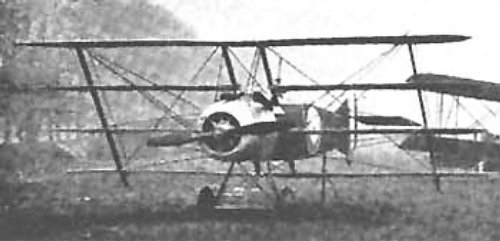|
Armstrong-Whitworth FK.10
The Armstrong Whitworth F.K.10 was a British two-seat quadruplane (''i.e.'', four wing) fighter aircraft built by Armstrong Whitworth during the First World War. While it was ordered in small numbers for the Royal Flying Corps and Royal Naval Air Service, it was not used operationally. It is one of the few quadruplane aircraft to reach production. Development The F.K.10 was designed in 1916 by Frederick Koolhoven,Mason 1992, p.76. the chief designer of Armstrong Whitworth Aircraft as a single-engine two-seat fighter. Koolhoven chose the novel quadruplane layout, also used by Pemberton-Billing (later known as Supermarine) for the P.B.29E and Supermarine Nighthawk anti-Zeppelin aircraft, and the contemporary Wight Quadruplane scout. At roughly the same time, Sopwith were building the successful Sopwith Triplane fighter. The first prototype, the F.K.9 Green and Swanborough 1994, p.25. was built and first flown in the summer of 1916, powered by a 110 hp (80 kW) Clerget 9 ... [...More Info...] [...Related Items...] OR: [Wikipedia] [Google] [Baidu] |
Fighter Plane
Fighter aircraft are fixed-wing military aircraft designed primarily for air-to-air combat. In military conflict, the role of fighter aircraft is to establish air superiority of the battlespace. Domination of the airspace above a battlefield permits bombers and attack aircraft to engage in tactical and strategic bombing of enemy targets. The key performance features of a fighter include not only its firepower but also its high speed and maneuverability relative to the target aircraft. The success or failure of a combatant's efforts to gain air superiority hinges on several factors including the skill of its pilots, the tactical soundness of its doctrine for deploying its fighters, and the numbers and performance of those fighters. Many modern fighter aircraft also have secondary capabilities such as ground attack and some types, such as fighter-bombers, are designed from the outset for dual roles. Other fighter designs are highly specialized while still filling the main ... [...More Info...] [...Related Items...] OR: [Wikipedia] [Google] [Baidu] |
Interplane Strut
In aeronautics, bracing comprises additional structural members which stiffen the functional airframe to give it rigidity and strength under load. Bracing may be applied both internally and externally, and may take the form of strut, which act in compression or tension as the need arises, and/or wires, which act only in tension. In general, bracing allows a stronger, lighter structure than one which is unbraced, but external bracing in particular adds drag which slows down the aircraft and raises considerably more design issues than internal bracing. Another disadvantage of bracing wires is that they require routine checking and adjustment, or rigging, even when located internally. During the early years of aviation, bracing was a universal feature of all forms of aeroplane, including the monoplanes and biplanes which were then equally common. Today, bracing in the form of lift struts is still used for some light commercial designs where a high wing and light weight are more imp ... [...More Info...] [...Related Items...] OR: [Wikipedia] [Google] [Baidu] |
1910s British Fighter Aircraft
Year 191 ( CXCI) was a common year starting on Friday (link will display the full calendar) of the Julian calendar. At the time, it was known as the Year of the Consulship of Apronianus and Bradua (or, less frequently, year 944 ''Ab urbe condita''). The denomination 191 for this year has been used since the early medieval period, when the Anno Domini calendar era became the prevalent method in Europe for naming years. Events By place Parthia * King Vologases IV of Parthia dies after a 44-year reign, and is succeeded by his son Vologases V. China * A coalition of Chinese warlords from the east of Hangu Pass launches a punitive campaign against the warlord Dong Zhuo, who seized control of the central government in 189, and held the figurehead Emperor Xian hostage. After suffering some defeats against the coalition forces, Dong Zhuo forcefully relocates the imperial capital from Luoyang to Chang'an. Before leaving, Dong Zhuo orders his troops to loot the tombs of the Ha ... [...More Info...] [...Related Items...] OR: [Wikipedia] [Google] [Baidu] |
Koolhoven Aircraft
N.V. Koolhoven was an aircraft manufacturer based in Rotterdam, Netherlands. From its conception in 1926 to its destruction in the Blitzkrieg in May 1940, the company remained the second major Dutch aircraft manufacturer (after Fokker). Although many of its aircraft were as unsuccessful economically as they were brilliant from a design standpoint, the company managed to score several 'hits', amongst them the Koolhoven FK-58, FK-58 single-seat monoplane fighter, the Koolhoven F.K.50, FK-50 twin-engine passenger transport, and the Desoutter Mk.II, FK-41, built in England under licence by Desoutter. History In 1920, aircraft designer Frederick Koolhoven, Frederick 'Frits' Koolhoven returned from England to his native Netherlands. The postwar years had not been good to him; the British Aerial Transport, British Aerial Transport Company for which he was chief designer went bankrupt and all other manufacturers were struggling for survival too hard to think of hiring. The Netherlands, Ko ... [...More Info...] [...Related Items...] OR: [Wikipedia] [Google] [Baidu] |

